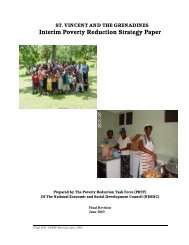The Anatomy of A Silent Crisis The Anatomy of A Silent Crisis
The Anatomy of A Silent Crisis The Anatomy of A Silent Crisis
The Anatomy of A Silent Crisis The Anatomy of A Silent Crisis
- TAGS
- anatomy
- www.bb.undp.org
Create successful ePaper yourself
Turn your PDF publications into a flip-book with our unique Google optimized e-Paper software.
24 Forum 2009: Climate Change – <strong>The</strong> <strong>Anatomy</strong> <strong>of</strong> a <strong>Silent</strong> <strong>Crisis</strong><br />
First, many may not have enough crop production to feed their families. Second, the shortfall <strong>of</strong><br />
their own crop may likely force them to buy food at a time when prices are high due to reduced<br />
global crop yields and population growth.<br />
Over 900 million are chronically hungry today—many <strong>of</strong> them due to climate change<br />
In 2008, the Food and Agriculture Organization <strong>of</strong> the United Nations estimated that more<br />
than 900 million are afflicted with hunger, or about 13 percent 70 <strong>of</strong> the global population. 71 Of those<br />
suffering from hunger, 94 percent 72 live in developing nations. 73 Most are subsistence farmers,<br />
landless families or people working in fishery or forestry. <strong>The</strong> remainder live in shanty towns on the<br />
fringes <strong>of</strong> urban areas. A quarter <strong>of</strong> the hungry are children. 73<br />
Climate change is projected to be at the root <strong>of</strong> hunger and malnutrition for about 45 million<br />
people, as a result <strong>of</strong> reduced agricultural yields <strong>of</strong> cereals, fruits, vegetables, livestock and dairy,<br />
as well as the cash crops like cotton and fish which generate income. 34 For example, drought hurts<br />
crops in Africa where over 90 percent <strong>of</strong> farmers are small scale and about 65 percent <strong>of</strong> people’s<br />
primary source <strong>of</strong> income is agriculture. 74<br />
By 2030, the number <strong>of</strong> hungry people because <strong>of</strong> climate change is expected to grow by more than<br />
two thirds<br />
Within 20 years, the number <strong>of</strong> hungry people as a result <strong>of</strong> climate change is projected to<br />
almost double to 75 million. 75 <strong>The</strong> reason for this increase is that the effects <strong>of</strong> climate change<br />
become more pronounced as temperatures rise. Within the same 20 years, climate change is<br />
projected to reduce global food production by approximately 50 million tons. 76 That, in turn,<br />
could force up global food prices by 20 percent. 76,77<br />
In some parts <strong>of</strong> Africa climate change is expected to reduce yield up to 50 percent by 2020. 78<br />
Historical evidence shows that higher food prices cause an immediate and direct jump in hunger<br />
levels. During the 2008 food crisis, the number <strong>of</strong> hungry people in the world increased by 40 million,<br />
primarily due to increased food prices. 71







